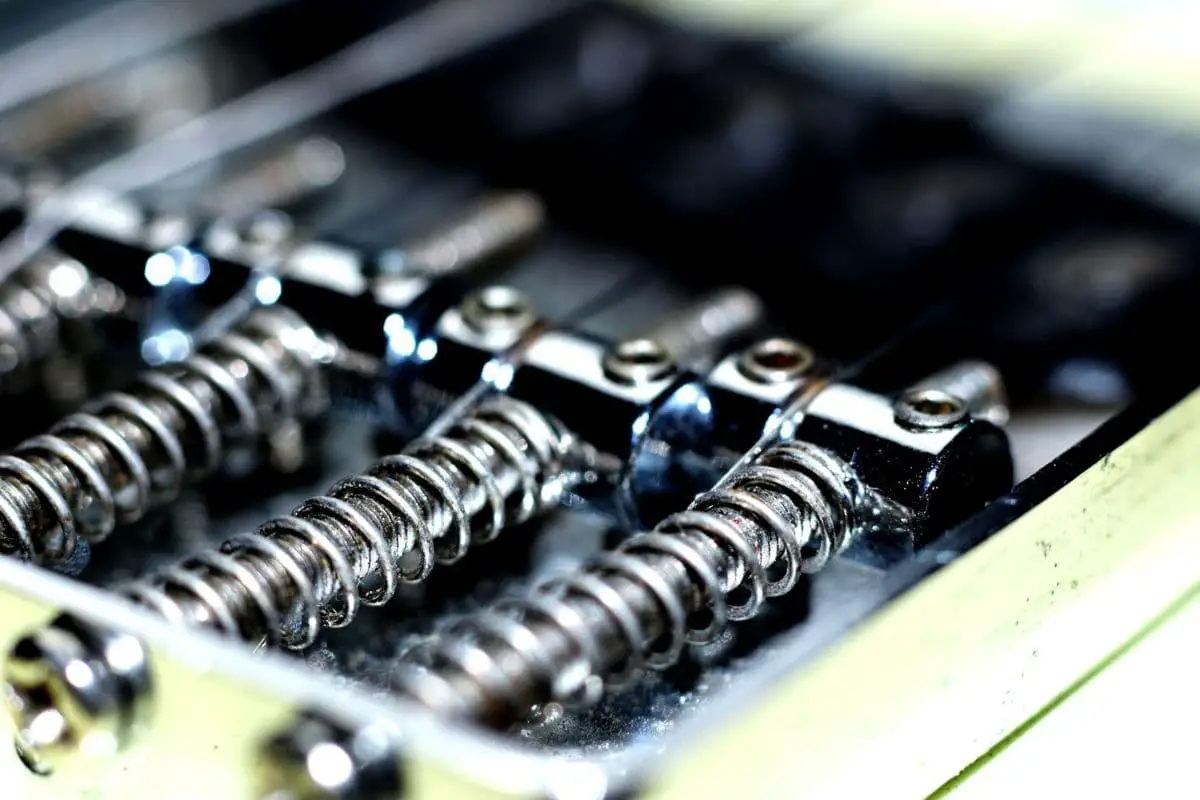Nobody wants to struggle with a guitar that keeps going sharp. Whether you are a casual player or a performing artist, the idea of tuning your guitar every time you want to play can be frustrating. There are many reasons why your guitar might be going sharp, some of which are easier to fix than others.
When a guitar keeps on going sharp, it might mean that the humidity where it is being stored is too high. It can also be that the nut slots are too shallow or the intonation is wrong. Possible fixes include using a two-way humidification system, filing your nut, and setting the intonation.
In this article, I will discuss eleven reasons why your guitar keeps going sharp. I will also give you the solutions to fix these issues so that you don’t have to struggle with them going forward. Let’s get started!
👇😀👇NOTE👇😀👇
If you want to find out what my recommended guitar gear is, then here is what I recommend on Amazon:
- Fender Cutaway Acoustic-Electric Guitar Bundle (MY FAVORITE GUITAR)
- Snark SN-8 Super Tight All Instrument Tuner (Easiest Tuner I’ve Used😏)
- 6 String Acoustic Guitar Capo (Best CAPO for quick changes)
- Dunlop Max Grip 1.0mm Nylon Picks (Thick Guitar Pick So You Don’t Lose Grip!)
- Universal Guitar Stand (Cheap & Minimalist Guitar Stand I Recommend)
- Levy’s 2″ Wide Quick Adjust Guitar Strap (Best Guitar Strap For Any Level)
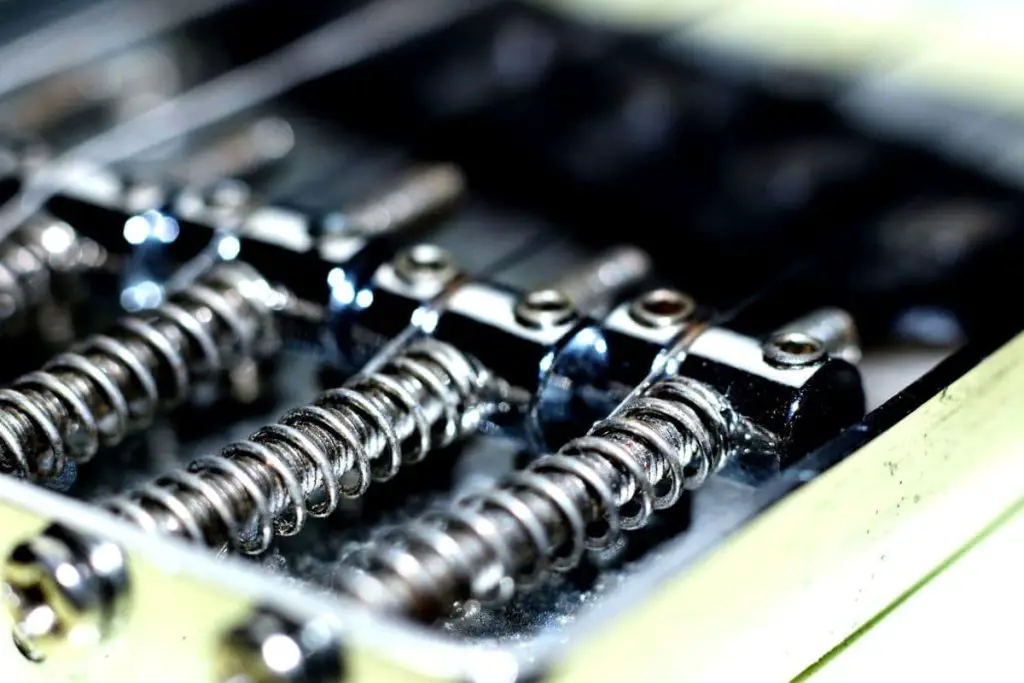
1. The Humidity Is Too High
More often than not, high humidity is the main cause for a guitar that keeps on going sharp. When the humidity rises, the wood your guitar is made of collects moisture and expands. This can cause the neck of your guitar to warp, which means it will start bending backward.
If the humidity is extremely high and you don’t do anything to fix the situation, the warp might be visible. If it is a slight warp, you might not even be able to see it. When the neck of your guitar bends backwards, even if it is slight, there will be more tension on the strings, which will cause your guitar to go sharp.
Since acoustic guitars have hollow bodies, they are more likely to suffer damage from high humidity. Humidity changes won’t affect solid-body electric guitars as much, but extremely high or low humidity can damage them.
How To Fix It
The best way to protect your guitar from high humidity is to regularly check the humidity levels and to ensure that you always store your guitar in a hardshell case.
The best humidity levels to store your guitar are between 45% and 55%. If you can keep the room humidity or the humidity within the guitar case between these numbers, your guitar will be much better off.
Suppose you live in an area with high humidity or where the humidity fluctuates significantly. In that case, I recommend getting a hygrometer like this Veanic 4-Pack Mini Digital Electronic Temperature Humidity Meters (available on Amazon.com).
You will get four of these mini hygrometers, which have a digital display so you can easily see the humidity levels. It will tell you the humidity and temperature, which are perfect for keeping your guitar healthy. The temperature is displayed in Fahrenheit, and it can read humidity levels between 10% and 99%.
You can put one of these hygrometers in your guitar case and another in the room where you keep your guitar.
If the humidity is too high, you can invest in a dehumidifier or get a two-way Humidification system like this D’Addario Guitar Humidifier System (available on Amazon.com). You simply have to place one or two of the pouches in your guitar case, which will automatically control the humidity levels, ensuring the relative humidity stays between 45% and 50%. This will protect your guitar from warping and cracking and ensure it doesn’t go sharp from humidity issues.
2. The Bridge Is Tilted
The bridge of your guitar may have tilted forward. The bridge or the saddle can come loose and move. It is also possible for the saddle or bridge to break.
When this happens, your strings can go out of tune, and your guitar can sound sharp. In the bridge, there are separate parts that hold each string. One or more of these pieces may have moved toward the head, leading to your guitar sounding sharp.
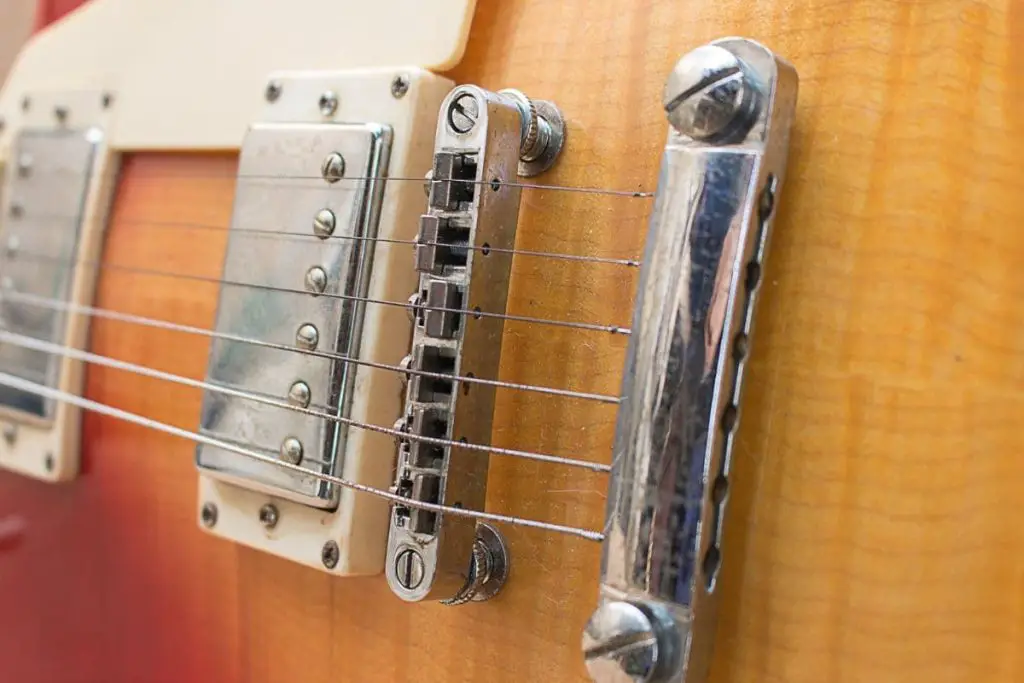
How To Fix It
Look closely at the bridge and saddle; if the saddle has caved in or the bridge is broken, you will have to replace them. If they have simply moved out of position, you can readjust them.
Look at the slot on the saddle and ensure that the bridge fits properly; if it is too loose, it will move again.
Always loosen or remove your strings before moving or adjusting the bridge or saddle.
3. Heavy Gauge Strings Can Cause Tension
If you recently changed your strings and decided to try a heavier gauge string, it can cause your guitar to go sharp. High gauge strings put more tension on the guitar’s neck and truss rod, leading to your guitar going out of tune.
Old strings won’t make your guitar sound sharp; instead, they will have a dull sound. Some guitarists like the sound of old strings, but most enjoy the vibrant sound of new strings.
Knowing when to change your strings may be tricky, so here are some signs that it may be time to replace your strings:
- If your strings are rusted.
- When strings start sounding dull.
- If your strings are bent, it’s better to replace them before they break.
- When your strings keep breaking and there aren’t any other possible causes.
A standard rule is that performing artists should change their strings every second week and casual players every two to three months.
How To Fix It
If you change to heavier gauge strings and they are causing too much tension, you can go back to lighter strings or reset your truss rod.
Adjusting the truss rod will allow for more relief on the neck, which will help your guitar stay in tune.
Be careful when adjusting the truss rod; always do so slowly and only turn it a quarter turn at a time.
Here is an informative YouTube video explaining how to adjust your truss rod:
4. Cold Temperatures Will Make Strings Go Sharp
When living in extremely cold areas, you might find that your guitar goes sharp often. Cold temperatures cause guitar strings to contract, making them sound sharp.
If cold temperatures are the reason why your guitar is sharp, you might have noticed that your strings will go back into tune by themselves as you play and they warm up.
How To Fix It
You can’t change the temperature, but how and where you store your guitar can make a huge difference. Always keep your guitar in a hardshell case and in a room where the temperature is relatively constant.
Don’t leave your guitar lying around the house, and never leave your guitar outside or in your car.
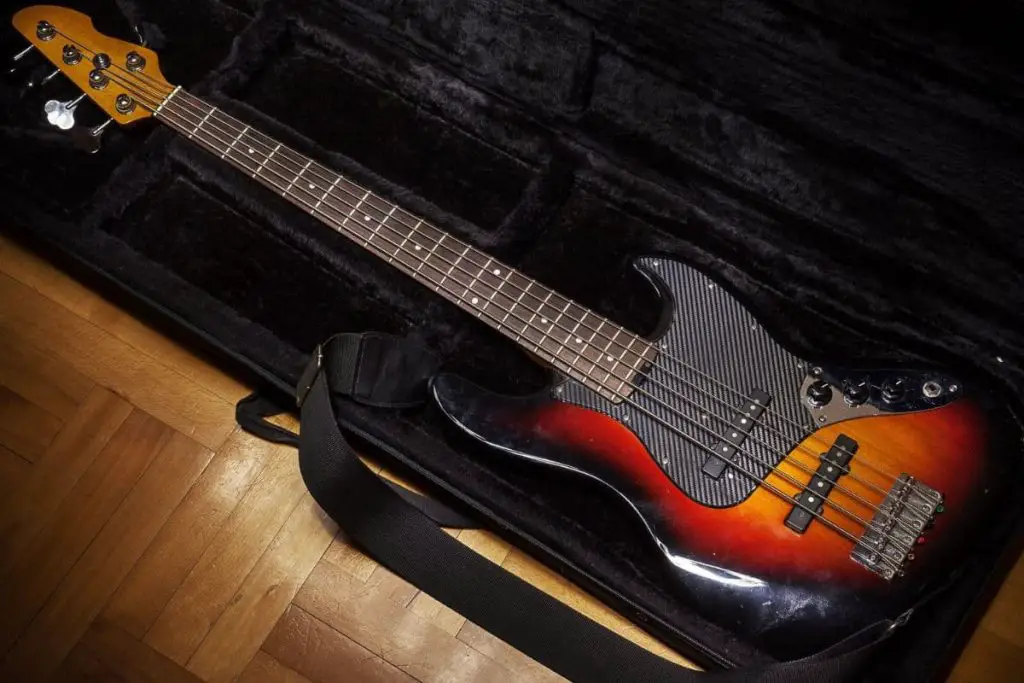
5. The Nut Is Too High or Tight
If the nut of your guitar is too high or too tight, your guitar will keep going sharp no matter how many times you tune it.
The nut can be too high because of excess glue beneath it, or the slots could have been carved too shallow. It is also possible that the slots are too tight, and the strings keep on binding in them.
How To Fix It
When your nut is too high, you can reposition it or file the slots, so they are slightly lower. This will cause your string action to be lower, which will, in turn, help your guitar stay in tune.
If your nut slots are the correct height, but your strings keep on binding, you can look at filing them so that they are smooth, but you will have to be careful. You do not want to remove too much material as a wide slot can cause many issues.
You can use pencil lead to lubricate the nut slots, which will help to keep them from getting stuck, or you can look at getting a special nut like this TUSQ Graph Tech Pre-Slotted Self-Lubricating Nut for electric guitars (available on Amazon.com)
It will fit on Gibson-style electric guitars with a ⅛-inch slot. Your guitar will sound better than ever, and you won’t have to worry about your strings binding. The nut is easy to install as it has extra height and length, so you can sand it to fit your guitar perfectly.
6. The Pickup Is Too High
If you have an electric guitar that keeps on going sharp, it could be that the pickup is too high. Pickups are essential for an electric guitar, but they must be installed correctly for optimal performance.
Pickups are made from magnets, and if the pickup is too close to the strings, the pull from the magnetic field can make the notes sound sharp.
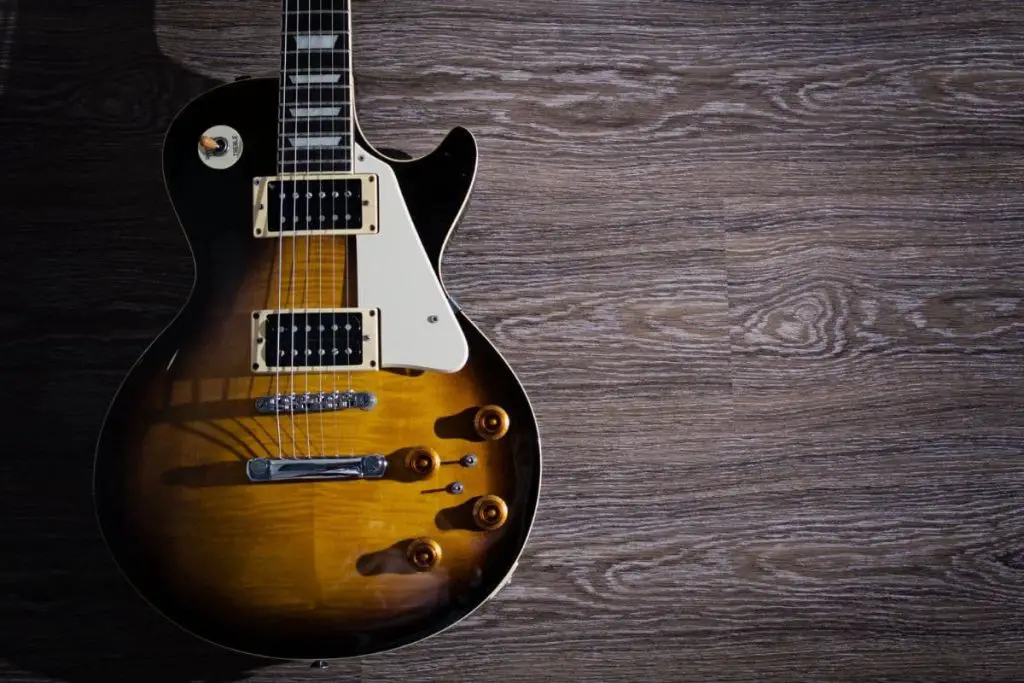
How To Fix It
To fix this issue, you simply have to lower your pickup. The magnetic pull will be less, and your strings will stay in tune.
7. Your Guitar Neck Is Bowed
When a guitar’s neck warps or bends, it can cause a lot of different issues, one of which is your guitar sounding sharp.
There are many reasons why your guitar neck can warp or bend, but some of the most common reasons are:
- High or low humidity.
- Leaning your guitar against a wall with its neck holding it in place.
- Too much tension from the strings.
- How your guitar is stored
How To Fix It
There are a few things you can do to fix a warped or bowed neck. If the neck is heavily damaged, you might need to take it to a professional for repairs.
If your neck angle is incorrect, it is possible that a shim could fix your problem.
Here are some tips to avoid or fix a bowed or warped neck:
- Ensure that your guitar is kept at the correct humidity. You can use a dehumidifier to remove excess moisture from the wood.
- Always store your guitar in a hardshell case if you have one. If not, you can keep it on a stand or hanger but do not lean it against the wall as it will put pressure on the guitar neck.
- Make sure to tune your guitar correctly. If you are planning on storing your guitar for a while without playing it, slightly loosen the strings to avoid too much tension on the neck.
- Adjusting the truss rod can help straighten the neck and remove tension. Be careful when adjusting the truss rod as it is sensitive, and you do not want to snap it.
8. Your Guitar Is High Action
If your guitar is high action, your notes will sound sharp. If your guitar’s action is too low, you will experience fret buzz. You need to find the perfect action for your guitar, which is not too high or too low.
How To Fix It
An electric guitar usually has a much lower action than an acoustic guitar. To adjust the action on an electric guitar, you can set the string height at the bridge, whereas, if you want to adjust the action on an acoustic guitar, you can set it at the bridge or nut as well as by adjusting the truss rod.
If you are not sure what the action for your guitar should be, you can use the below measurements as a starting point:
- Action for an electric guitar: 4/64” (1.58 mm) on high E and 6/64” (2.38 mm) on low E.
- Action for an acoustic guitar: 5/64” (1.98 mm) on high E and 7/64” (2.77 mm) on low E.
Before you start adjusting your action, you need to measure it. You can use an action gauge or ruler to ensure that you set your action perfectly to avoid your guitar going sharp in the future.
Here is a YouTube video showing how to measure your guitar’s action:
9. The Whammy Bar Is Causing Tension
Knowing how to use a whammy bar can be fun and impressive, but your whammy bar can be what is causing your guitar to go sharp.
When using the whammy bar, the bridge experiences a lot of tension which can cause your strings to tighten and your guitar to go sharp.
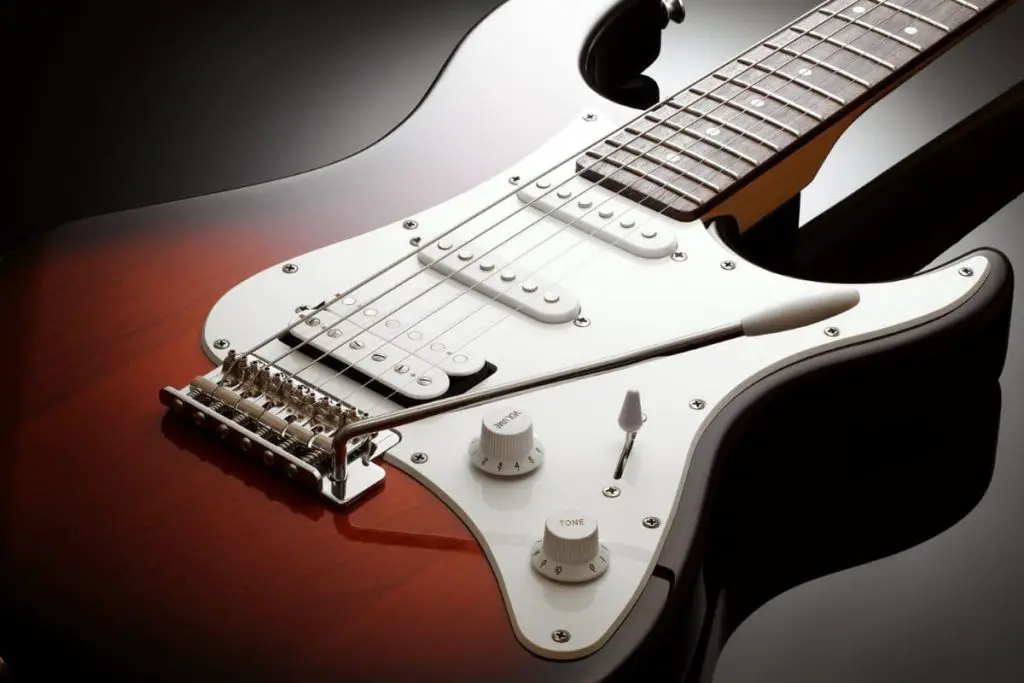
How To Fix It
You can set the tension that your whammy bar puts on the bridge by adjusting the springs. If you set the tension correctly, the bridge won’t have as much pull on it, so your strings won’t go sharp.
10. A Capo Can Put Tension on the Strings
If you are somebody who uses a capo a lot, it can lead to your guitar going sharp. A capo works like a clamp and can cause your strings to bend when used often. When a string bends, it causes tension which in turn causes your guitar to sound sharp.
How To Fix It
This is an easy fix. You can stop using a capo or simply learn the correct placement and tuning so that you don’t damage your strings.
The best position for your capo is right behind the fret, not on top of it. Once you have placed your capo, you will want to tune your guitar again, as the tension from the capo will automatically cause the strings to sound sharp.
Do not use a capo that puts too much pressure on the strings, as this will bend the strings, and your guitar will keep going sharp. When tuning your guitar with the capo in place, you can add gentle pressure on all of the strings close to the bridge with your free hand. This will help with tuning and avoid your strings going sharp.
11. Your Guitar Intonation Is Wrong
Your guitar’s intonation must be correct, or it will never stay in tune. Many things can affect the intonation, and you will have to spend some time figuring out what is causing the issue.
If your intonation is wrong, some strings might be in tune while others are sharp.
Some issues that can affect your guitar intonation include:
- Truss rod
- Bridge height
- String changes
- Tuning pegs
- Length of your strings
- Neck placement
How To Fix It
Setting the intonation on your guitar can be challenging to get right, and it might be a good idea to take it to your local guitar shop.
If, however, you want to try it yourself, here are some tips:
- When setting your intonation, always do it with new strings. Old strings don’t hold tension as well as new strings and can cause tuning issues.
- Always remove and replace one string at a time. By removing all of the strings simultaneously, you are removing all of the tension from the neck, which can cause it to move.
- If you remove all of the strings before replacing them or adjusting the truss rod, you should wait a couple of days and then tune your guitar again as the neck takes a few days to settle into the correct position.
- Check that your tuning pegs are tight and haven’t gone loose.
- The notes at the 12th fret should be in tune with your open strings.
- The length of your strings may be incorrect. If the 12th fret is sharp, the string needs to be longer.
- If the 12th fret is flat, the string needs to be shorter.
- Once you have adjusted the length of your strings, you need to tune them.
- If your guitar is still sharp or flat, you need to adjust the truss rod.
- Tune your guitar in the playing position, and then give the neck a few days to settle before tuning it again.
When adjusting the truss rod, do so carefully. The truss rod is sensitive and can snap if you put too much pressure on it. Always only turn it a quarter turn at a time.
Final Thought
There are many reasons why your guitar could be going sharp, but there is always a way to fix it. The most important thing is to ensure that you store your guitar somewhere safe. Make sure that humidity isn’t too high and that you don’t keep it close to any heat sources. You should also have a good maintenance schedule to pick up any issues early on.
There are many ways to fix a guitar that keeps on going sharp, but if you can’t figure out the problem, your local guitar shop will be able to help.
👇😀👇NOTE👇😀👇
If you want to find out what my recommended guitar gear is, then here is what I recommend on Amazon:
- Fender Cutaway Acoustic-Electric Guitar Bundle (MY FAVORITE GUITAR)
- Snark SN-8 Super Tight All Instrument Tuner (Easiest Tuner I’ve Used😏)
- 6 String Acoustic Guitar Capo (Best CAPO for quick changes)
- Dunlop Max Grip 1.0mm Nylon Picks (Thick Guitar Pick So You Don’t Lose Grip!)
- Universal Guitar Stand (Cheap & Minimalist Guitar Stand I Recommend)
- Levy’s 2″ Wide Quick Adjust Guitar Strap (Best Guitar Strap For Any Level)

